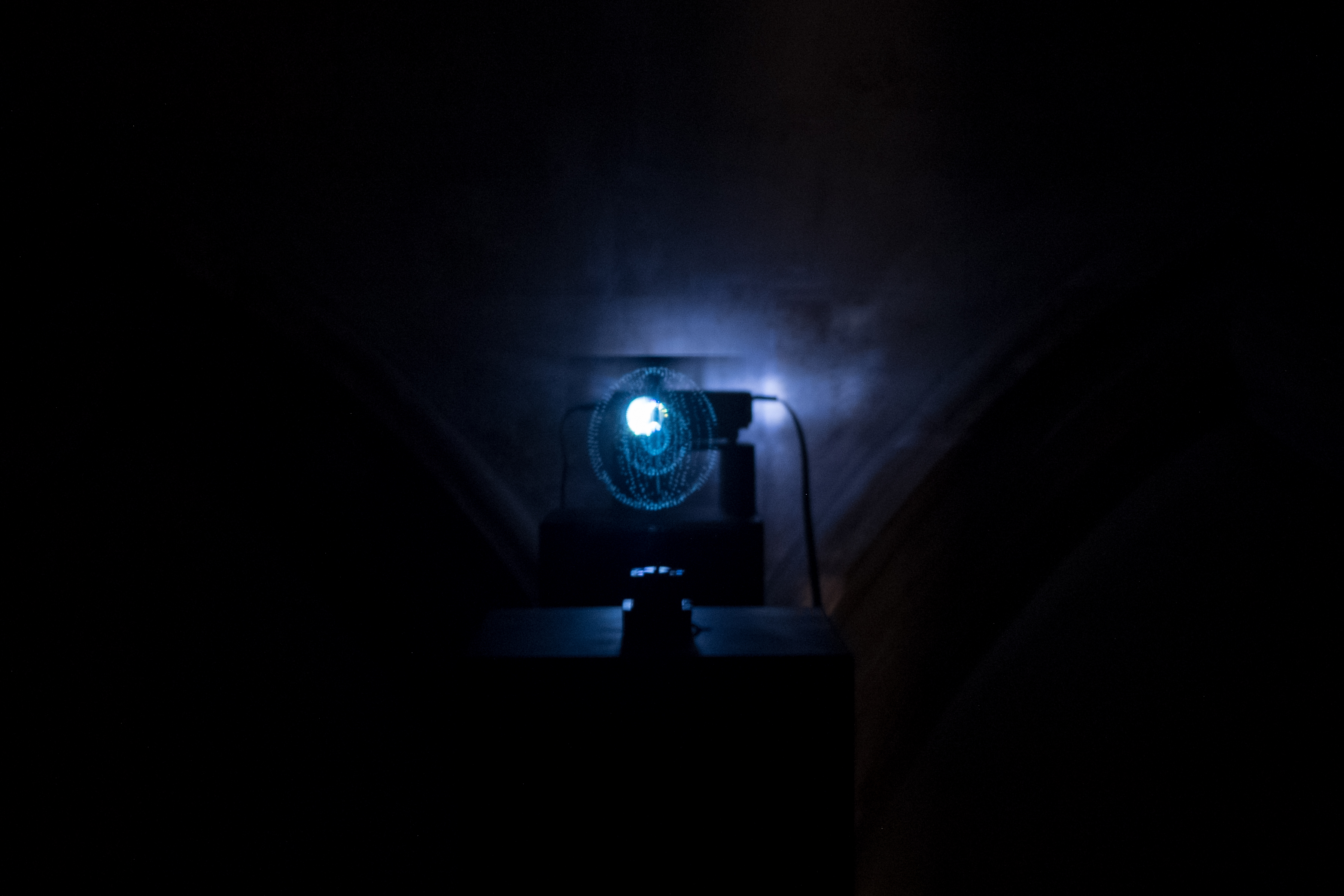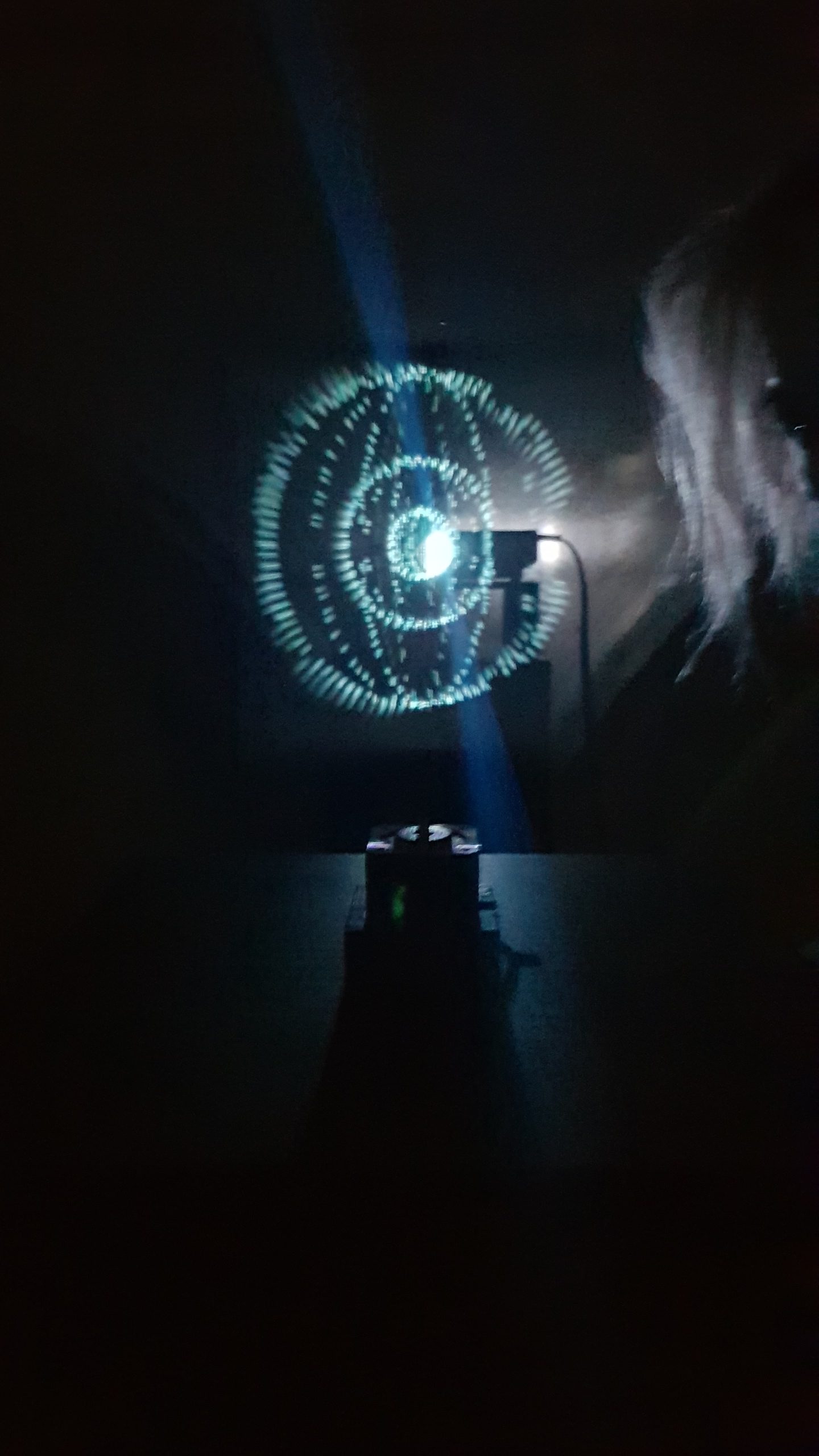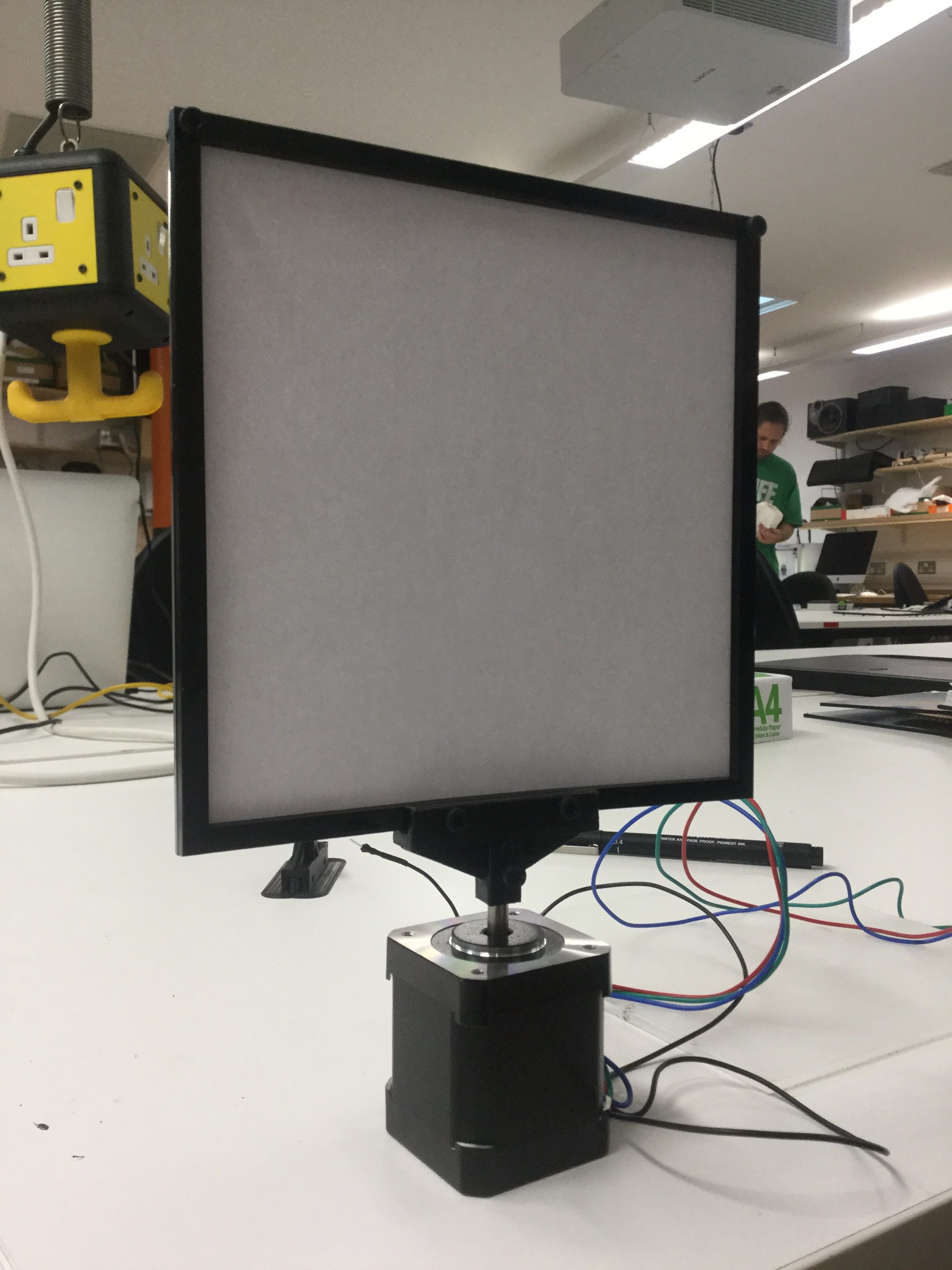Afterimage
Afterimage is an exploration of visual perception, form and materiality. It is an attempt to give form to the immaterial -- a translation from computational description of three-dimensional geometry into physical space through volumetric projection.
produced by: Keita Ikeda
Introduction
I don't like to make work that requires explanation. I want my work to be as pure a sensory experience as possible, a phenomenon that the viewer can observe and have some kind of emotional response to. I want my work to speak for itself, the way nature does; it speaks affectively without any need for semantics.
Unfortunately, this whole blog post is an explanaton of my work. This piece in particular was designed specifically for unmediated, embodied viewing for the human body, and I fear that my attempt to write about it will remove it from its essence as a physical phenomenon -- this will inevitably be an abstraction, if not reduction, of the piece itself. Furthermore, I'd like my work to be open to interpretation. I worry that I will prescribe meaning for the piece by disclosing my interpretation of it. If I'm perfectly honest, I'd rather you stopped reading here -- still, I will try to document the thoughts and processes behind the work (and not necessarily the work itself).
Concept and background research
This project was an attempt to firmly engage with computation as an artistic medium. Through making, I wanted to think about what might be unique and fundamental to computation as a medium. I was primarily influenced by artists working with light who (re)invent their own medium, such as Olafur Eliasson, Thomas Wilfred and Stanley Kubrick. I therefore situate my work in the intersection between light art and computational art.
I was particularly inspired by Anthony McCall's approach to his "solid light" works, in which he projects simple lines through haze, revealing the volumetric and sculptural quality of light. For McCall, a film maker, this was the ultimate film, distilled to its essential elements: light and time. Through deconstructing and reconstructing what he thought was the essence of his medium, McCall elevated the language of film from pictorial representation to physical phenomenon. The title of the first "solid light" piece, Line Describing a Cone, resonates with the concept of this project -- the very process of information materialising through a medium, the "describing", takes centre stage. Here, the medium is the content (McLuhan 2001).
In this project, I wanted to engage with computation in a similar way. Fundamentally, computers can only do two things: store information, and perform calculations. But modern computers can do these two things extremely well -- they can process high volumes of data at high speeds. This was to be exploited to make something uniquely computational. Inspired by McCall, I knew I wanted to work with physical space and light. The project naturally converged to a search for a way to translate computational description of three-dimensional geometry into physical space, which would only be possible with modern computers.
The search found its answer when I came across a 3D printing technique published by B. E. Kelly et al (B. E. Kelly et al 2019). By rotating a container of photosensitive resin that hardens in reaction to light and projecting 2D "compressions" of a 3D object in sync, they were able to render 3D forms. I realised that I could do the same with a projection screen and "slicing" 3D objects instead of "compressing" it -- really fast, so that the 2D slices "fuse" for the human eye through persistence of vision, rendering volumetric form in physical space.
Creating the content for this system was very much a subtractive process. I tested, for example, realistic human faces using a Kinect -- I realised that it brought in too any unwanted meanings and that I needed a minimalistic approach to ensure that the focus was on the medium. Colour also had to go in favour of uniform pale cyan. Three was enough dimensions, and the resulting experience of adding colour to the piece, I felt, lacked focus. In the end, I settled on three concentric spheres; a shape dynamic enough in depth to do the system justice, while at the same time so ubiquitous that its meaning is open to interpretation.
Anthony McCall's Line Describing a Cone
Technical
Overview
The system that I implemented for this piece is a volumetric projection system, often incorrectly referred to as a 'hologram'. Physically, it is a framed piece of paper spinning on a stepper motor. The bespoke programme calculates and projects "slices" of three-dimensional geometries, accounting for the screen's position in space. This renders a volume of light in physical space. Since each slice appears and disappears faster than the human eye can process(in this case at 60 Hertz), the slices appear to fuse, creating a volumetric afterimage through persistence of vision.
Physical Mechanism/Arduino
The piece of paper is held in a laser cut frame, which in turn is mounted on a stepper motor with a 3D printed attachment. These parts prevent the paper from deforming when spun at high speeds, allowing the projection to be more accurate. The motor is controlled with an Arduino, using the AccelStepper library. The Arduino programme sends the openFrameworks programme a serial message every full rotation, which is used to recalibrate the position of the paper and the projection.
openFrameworks
I implemented a class called RSP(Revolving Screen Projector) in openFrameworks. It stores 3D geometries as groups of 3D vectors in a normalised space (the mathematical vectors, not the C++ sequence containers). These points are organised into voxel-like clusters, and given the angle of the motor, it calculates which of the clusters need to be projected using simple trigonometry (see image below), in effect slicing the 3D geometry into 2D slices.
The projection can be scaled up and down at will, making it possible to be used at any scale. In addition to this, the programme allows the user to scale the projection according to the vector's position on the z-axis(the depth), so as to account for the increasing image size as the distance between the projector and the screen surface increases.
I have also implemented a few classes for utility, chiefly to convert geometries described with lines to series of points. the programme dynamically sets the resolution of lines, according to the number of voxels as defined in the header file dedicated to programme-wide settings.
Challenges
The most challenging part of this project was the physical aspect. It took me weeks to figure out the appropriate material to project on. It needed to be light enough to be spun on a stepper motor, have a good range of viewing angle, and somehow secured so that it doesn't deform. I tried materials such as lighting gel and frosted acrylic, which were too reflective and too heavy, respectively. It's interesting that paper, such an old and pedestrian medium, turned out to be the solution. I managed to secure the paper onto the motor with especially designed parts, but not without major help from my friend Julien Mercier -- thanks Julien 🙂
Future development
I plan to continue working with the system that I built for this project. Because of the focus on the medium, the content in this iteration was necessarily minimalistic. I feel that there's still much to be explored in terms of form, colour and change over time. Perhaps I can experiment with higher-dimensional geometries, such as a tesseract -- although any more than four dimensions may become redundunt, because the shapes would have to be projected down to 3D anyway. Such experiments, I believe, would be uniquely computational, in that it is impossible for a human to calculate and render such complex geometries at such a high speed with other mediums of artistic expression. I would also like to experiment with a high speed projector.
Self evaluation
This project, especially the physical computing component, was certainly challenging, but I'm glad I undertook it. I feel that it pushed my practice in an interesting direction. I position this piece as a first in a series, and plan to continue working with the system, as there is much more to be explored.
References
AccelStepper library documentation. http://www.airspayce.com/mikem/arduino/AccelStepper/classAccelStepper.html
Brett E. Kelly, Indrasen Bhattacharya, Hossein Heidari, Maxim Shusteff, Christopher M. Spadaccini, Hayden K. Taylor. "Volumetric additive manufacturing via tomographic reconstruction", Science, 08 Mar 2019 : 1075-1079
Marshall McLuhan. Understanding Media : The Extensions of Man. London: Routledge Classics, 2001. Print.
Tim Edensor. Light Art, Perception, and Sensation, The Senses and Society, 2015: 10:2, 138-157



































































